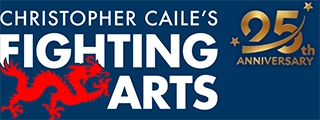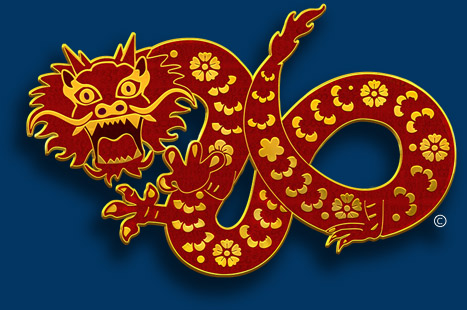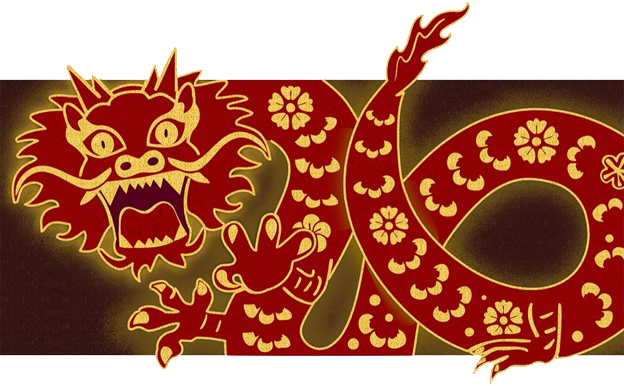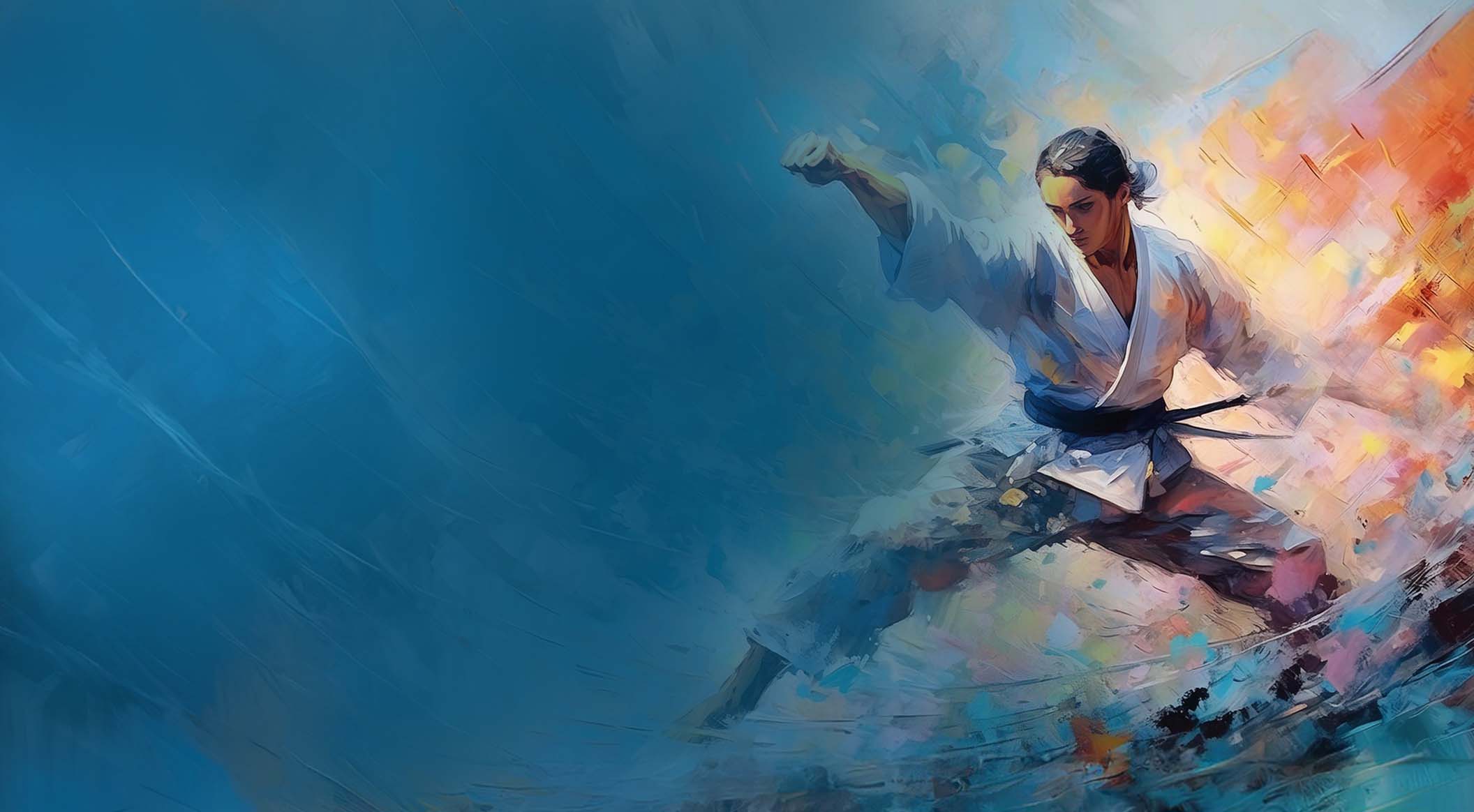Interview With Roy Suenaka On Hohan Soken & Tuidi
By Christopher Caile
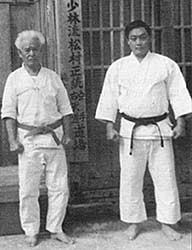 |
Grand Master Hohan Soken with his student Roy Suenaka outside his home on Okinawa in 1970 |
Introduction
Roy Suenaka Sensei is best known as the founder of Wadokai Aikido, which reflects his own training directly under aikido’s founder, Morihei Ueshiba, as well as Koichi Tohei. Less known is Suenaka’s long term in-house study with Hohan Soken, the great Okinawan karate master known for his White Crane karate. White Crane was taught to senior students inside a Shorin Ryu karate curriculum. Soken traced his techniques to Bushi Matsumura (1762-1843), the great Shuri karate master, body guard to the Okinawan king and diplomat. Matsumura served as a well spring from which a whole generation of Okinawan karate pioneers emerged.
|
Today Suenaka Sensei, 8th dan, continues Soken’s karate legacy in Charleston, S.C., teaching his Matsumura Seito Hakutsuru (Orthodox Matsumura White Crane) Shorin-ryu Karate-do and Kobudo (weapons). The style is crisp yet graceful, incorporating some grappling and many traditional karate weapons. White Crane techniques are soft and flowing contrasted to the harder, more direct power of traditional Shorin-Ryu. In addition to karate, Soken is known for his tuidi, (1) also sometimes referred to as tuite, toude, torite or karamiti. |
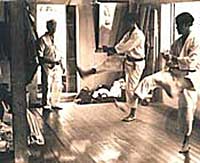 |
An old photo showing Hohan Soken leading students in a small class conducted on the porch of his home on Okinawa. |
Toudi is rarely seen today. If practiced at all, it is considered a complement to karate, not part of it. Tuidi means grabbing/gripping hand and includes an eclectic panorama of self-defense techniques. Included are parrying, entangling, entrapment, grabbing, body and arm control techniques, plus pressure point striking and nerved control techniques

Roy Suenaka who teaches Soken’s Matsumura Seito Hakutsuru Shorin-ryu Katatedo and Kobudo along with his own Wadokai Aikido in Charleston, S.C. executes a simultaneous open hand counter and foot tuidi technique on his senior student Chad Taylor.
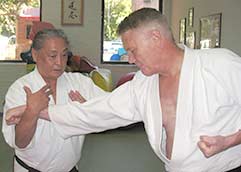
Roy Suenka shows a tuidi trap of a punch thrown by Christopher Caile. Notice Suenaka’s open hands on either side of the punching arm, the left just below the outside of the elbow (deflecting the punch) the other inside the wrist tapping the arm — the two together allowing capture of the arm and control of the elbow (also unbalancing forward). Typically with this technique the elbow can be broken or bent inward unbalancing the attacker and creating an opening for a variety of counter attacks.
The art’s origin is obscure. Some historians suggest toudi was once part of old time karate (often referred to as “ti” or “te”, meaning hand), but was lost in karate’s transition to modern form. Others suggest “ti” (hand) refers to old Okinawan karate, while tuidi refers to techniques derived from Chinese roots (often called tode, meaning Chinese Hand, the term sharing the same characters, but pronounced differently from the original characters used for karate). Still others suggest that tuidi represents a separate and older Okinawan indigenous art. No one knows for sure. In some ways the art of tuidi is similar to Chinese chin na, comprising jujutsu or aikido-like techniques, plus grabbing and striking components. Many of these techniques Suenaka routinely teaches as part of his karate. The are also included in many aikido classes, seminars and camps.
Interview
Q: How did Hohan Soken refer to the old Okinawan art that complemented his karate? Did he call it tuidi, tuite, toude, torite or something else?
Suenaka: Soken Sensei pronounced it as tuidi (tu-ee-d). I know others refer to it by other names but Soken may have called it toudi because of the area that he lived in. That part of Nishihara is considered the backwoods country of Okinawa and thus the term may have been an older pronunciation.
Q: How are tuidi foot movements you learned from Hohan Soken different from those in aikido?
Suenaka: Basically the footwork is very similar in that you step at angles or you pivot out the way of an attack. The tuide portion is also similar to aikido in that you don’t grab or don’t actually block, but blend with the attack to capture it.
Q: In aikido you most often end with a throw?
Suenaka: With a wrist or other body part.
Q: In some tuidi techniques you seem to be actually off balancing the opponent with elbow positions, or by something else, such as by pulling them in, and then finishing up with a …. (Suenaka finished the sentence).
Suenaka: … with a strike or a disabling never strike, yes.
Q: When you practiced with Soken, what was the typical practice? How much would you be practicing tuide versus kata?
Suenaka: Well, we would be doing kata and then apart from kata we would go through their separate movements, like bunkai (break down of kata technique). I would often practice this by myself. When we would practice tuidi, we of course would have to work with a partner. Basically, if it was one on one, it would be myself and Soken Sensei and he would be showing me tuidi. Most of the emphasis was on tuidi rather than on kata bunkai. Of course, we did some kata bunkai too. The kata we practiced alone. Soken would teach a kata and then let you practice it yourself, over and over. Often he would leave you alone, only to check you later.
Q: So Soken preferred tuidi?
Suenaka: Oh yes. In the average session in Soken’s house if I was not doing kata (he often practiced alone), we would be doing tuidi.
Q: Did Soken tell you how he learned tuidi?
Suenaka: Well, actually he knew Go Genki (an Okinawan White Crane exponent also known to have influenced Chojin Miyagi, the founder of Goju ryu Karate), and traded lessons with him. He also knew Chomo Hanashiro Sensei (a student of Anko Itosu, who had also briefly studied with Bushi Matsumura, and was famous for introducing karate into the school system of Okinawa), and Kenwa Mabuni (founder of Shito-Ryu karate, known for his study with both Itosu and Kanyro Higaonna, the primary teacher of Miyagi). They worked out together and traded technique. But as to actual tuidi, or the Hakutsuru (White Crane) portion of his Matsumura Seito (meaning orthodox Matsumura), he told me that he learned it from his uncle, Nabe Matsumura (who learned it under Matsumura himself).
Q: In Tuidi you don’t just use your normal fist?
Suenaka: Right, right. We use ipon ken (forefinger fist, a fist using an extended first knuckle for striking, a weapon also common among forms of White Crane) and other finger techniques — to the eyes, neck and nerve points. Soken would also use his thumb to hit with.
Q: When you did tuidi, were there any leg techniques?
Suenaka: Mostly hand techniques. Of course there was some kicking, but mostly tuidi referred to hand technique. … to break, strike or do some nerve technique.
Q: What did Soken think of your aikido?
Suenaka: He actually thought highly of it. He never put down other martial arts. He thought all were good. I would hear questions about it, especially after I went to his house after I had instructed aikido. He asked a lot of questions. I think he liked it. In fact I did a lot of demonstration of aikido for him.
Q: What did Soken teach in his private house practices versus what he would teach on the outside?
Suenaka: He taught a lot more of the tuidi and more sophisticated technique at home versus what he taught when he traveled. He did a lot more of the basic Shorin-Ryu when he taught outside.
Q: When Soken taught you kata, did he teach you a few moves or all at once?
Suenaka: He would teach the whole thing. Oh yeah. And it was up to you to be able to follow after the two or three times he would show it. And that would be it for a while and later he would usually ask later if you had any questions and if you did he would show you the kata again. Otherwise you had to basically remember everything he had shown you. It was pretty hard learning from him.

Roy Suenaka demonstrates a tuidi intercept and counter with Christopher Caile. In this photo Suenaka begins to parry Caile’s right punch.
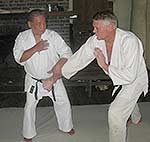
Suenaka parries the punch downward and across his body, the attacker being pulled forward and off balance as Suenaka rotates to the outside. Suenaka keeps his right hand ready to counter.
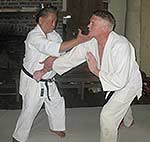
Roy Suenaka still controlling the right punch of Christopher Caile (having pulled it down and forward) rotates back (now square, but angled to the side) and executes a right open hand finger tip technique to Caile’s throat.
Footnote:
(1) The term tuidi should not be confused with a similar term “toudi,” or  “tode” which translates (from the Japanese Characters, Kanji) as “kara” meaning Tang hand. Tang refers to Tang China (thus by inference meaning China) and “di” or “te” means hand (an old Okinawan term used to refer to various forms of empty hand fighting arts). Since Japanese characters have multiple reading (meaning possible pronunciations), another pronunciation for toudi or tode is karate, translated as Chinese hand. Once karate was adopted into Japan, however, it was decided to change the term karate by using another character also voiced as “kara” to replace the character for  China. The new character had the meaning “empty.” The pronunciation remained the same but  karate now had a new first character and a new meaning — empty hand. The character for empty in Japanese does not have an alternative pronunciation as “to” (or tou as in toudi).  Thus toudi or tode cannot have the meaning of empty hand, only Chinese hand.
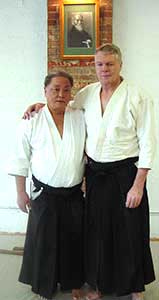 |
Roy Suenaka, founder of Wadokai Aikido, with Sensei Christopher Caile |
About the Author Christopher Caile
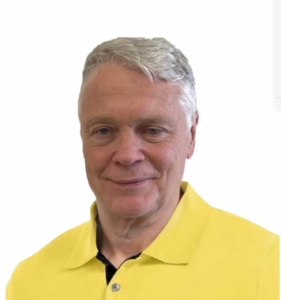
Screenshot
Christopher Caile is the Founder and Editor-In-Chief of FightingArts.com. He has been a student of the martial arts for over 65 years.
He first started in judo while in college. Then he added karate as a student of Phil Koeppel in 1959 studying Kempo and Wado-Ryu karate. He later added Shotokan Karate where he was promoted to brown belt and taught beginner classes. In 1960 while living in Finland, Caile introduced karate to that country and placed fourth in that nation’s first national judo tournament.
Wanting to further his karate studies, Caile then hitch hiked from Finland to Japan traveling through Scandinavia, Europe, North Africa, the Middle East and South and Southeast Asia — living on 25 cents a day and often sleeping outside.
Arriving in Japan (1962), Caile was introduced to Mas Oyama and his fledgling full contact Kyokushinkai Karate by Donn Draeger, the famous martial artist and historian. Donn also housed him with several other senior international judo practitioners. Donn became Caile’s martial arts mentor, coaching him in judo and introducing him to Shinto Muso-ryu under Takaji Shimizu.
Caile studied at Oyama’s honbu dojo and also at Kenji Kurosaki’s second Tokyo Kyokushinkai dojo. In his first day in class Oyama asked Caile to teach English to his chief instructor, Tadashi Nakamura. They have been friends ever since. Caile also participated in Oyama’s masterwork book, “This Is Karate.”
Caile left Japan with his black belt and designation as Branch Chief, the first in the US to have had extensive training in Japan directly under Oyama Sensei. As such, Oyama Sensei asked him to be his representative on visits to his US dojos to report on their status.
A little over a year later, Nakamura, Kusosaki and Akio Fujihira won an epic David vs. Goliath challenge match against Thailand’s professional Muay Thai Boxers in Bangkok, Thailand, thrusting Kyolushinkai and Nakamura into national prominence.
Back in the US Caile taught Kyokushinkai karate in Peoria, Il while in college and later in Washington, DC. while in graduate school. Durimg this time Shihan Nakamura had moved to New York City to head Kyokushinkai’s North American Operation.
In 1976 when Kaicho Tadashi Nakamura formed the World Seido Karate organization, Caile followed. Living then in Buffalo, NY, Caile taught Seido karate and self-defense at the State University of New York at Buffalo (SUNY Buffalo) for over 15 years where he also frequently lectured on martial arts and Zen in courses on Japanese culture.
Caile moved to New York City in 1999 to marry Jackie Veit. He is now an 8th degree black belt, Hanshi, training in Seido Karate’s Westchester, NY Johshin Honzan (Spiritual Center) dojo. In Seido Caile is known for his teaching of and seminars on kata applications. He also produced a 14 segment video series on Pinan kata Bunkai currently available to Seido members.
Caile is also a long-time student and Shihan in Aikido. He studied in Buffalo, under Mike Hawley Shihan, and then under Wadokai Aikido’s founder, the late Roy Suenaka (uchi deshi under Morihei Ueshiba, founder of Aikido and was Shihan under Tohei Sensei). In karate, Suenaka (8thdan) was also an in-house student of the Okinawan karate master Hohan Soken.
Having moved to New York City, Caile in 2000 founded this martial arts educational website, FightingArts.com. Twenty-five years later, in 2025, it underwent a major update and revision.
For FightingArts.com and other publications Caile wrote hundreds of articles on karate, martial arts, Japanese art, Chinese Medicine and edited a book on Zen. He also developed relationships with a cross section of leading martial arts teachers. Over the last four decades he has conducted extensive private research into karate and martial arts including private translations of the once secret Okinawan hand copied and passed on Kung Fu book, the Bubishi, as well as an early karate book by the karate master Kenwa Mabuni. He periodically returns to Japan and Okinawa to continue his studies and participate Seido karate events. In Tokyo he practiced (with Roy Suenaka Sensei) in a variety of aikido organizations with their founders – including private interviews and practices at the Aiki-kai Aikido Honbu dojo with the son and grandson of aikido’s founder, Doshu (headmaster) Kisshomaru (an old uchi-deshi friend) and his son, Moriteru Ueshiba and in Iwama with Morihiro Saito. On Okinawa he studied Goju Ryu karate under Eiichi Miyazato, 10th dan founder of Naha’s Jundokan, and also with Yoshitaka Taira (who later formed his own organization, who specialized in kata Bunkai. While there Caile also trained with Hohan Soken’s senior student, Master Fusei Kise, 10 dan as well as with the grandson of the legendary karate master Anko Itosu.
Caile’s other martial arts experience includes: Diato-ryu Aikijujitsu and Kenjitsu, kobudo, boxing, Muay Thai, MMA, Kali (empty hand, knife and bolo), study of old Okinawan Shoran-ryu & Tomari body mechanics, study of old Okinawan kata under Richard Kim, study of close quarter defense and combat, including knife and gun defenses, Kyusho Jitsu and several Chinese fighting arts including 8 Star Praying Mantis, Pak Mei (White Eyebrow), and a private family system of Kung Fu.
Caile is also a student of Zen as well as a long-term student of one branch of Traditional Chinese Medicine, Chi Kung (Qigong). As one of two senior disciples of Chi Kung master Dr. Shen (M.D., Ph.D.) Caile was certified to teach and practice. This led to Caile’s founding of the The Chi Kung Healing Institute on Grand Island, NY. In Western NY, he also frequently held Chi Kung seminars, including at SUNY Buffalo and at the famous Chautauqua Institution in Chautauqua, NY. His articles on Chi Kung also appeared in the Holistic Health Journal and in several books on alternative medicine.
Caile holds a BA in International Studies from Bradley University and MA in International Relations with a specialty in South and Southeast Asia from American University in Washington, D.C. While in Buffalo, NY he also studied digital and analog electronics.
In his professional life Caile also worked in public relations and as a newspaper reporter and photographer. Earlier he worked in the field of telecommunications including Managing a Buffalo, NY sales and service branch for ITT. He then founded his own private telephone company. This was followed by creation of an electrical engineering company that designed and patented his concept for a new type of low-cost small business telephone system (which was eventually sold to Bell South). The company also did contract work for Kodak and the US space program. Simultaneously Caile designed and manufactured a unique break-apart portable pontoon boat.
Most recently Caile co-founded an internet software company. Its products include software suites with AI capability for control and management of streaming media, such as video and music, an all-in-one book publishing software product for hardcover, eBook and audio book creation and security software for buildings and government use.
For more details about Christopher Caile’s martial arts, work experience and life profile, see the About section in the footer of this site.
Search for more articles by this author:
